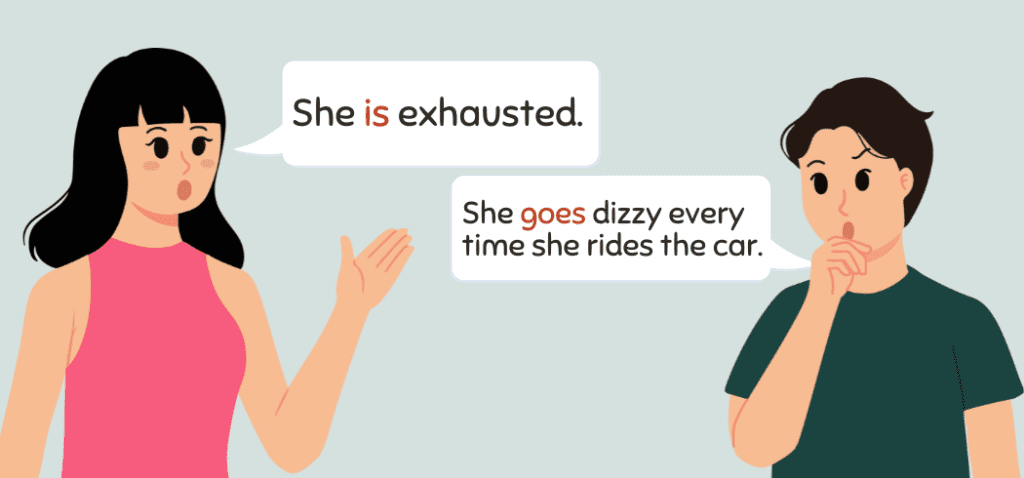Linking verbs do not have the same role as typical verbs that show action. The function of this verb type is to link a subject to its subject complement.
What is a linking verb? What are all the linking verbs? My handy dandy guide will show you the meaning, functions, and list of all linking verbs in the English language. Then, you can answer the worksheet I provided to check your understanding.
What Are Linking Verbs?

A linking verb does not show action like dynamic verbs. Instead, it is a type of verb that expresses a subject’s state of being. This function sets them apart from intransitive verbs, phrasal verbs, and impersonal verbs. For example:
- Your dress feels silky.
In this sentence, feels establishes the state of being of the subject dress. It does not express the dress doing the act of feeling.
Some linking verb examples include is, feel, smell, and became. The most common linking verb is be in all its forms, such as is, was, am, and more. Here are more sentence examples.
- I am happy to see you.
- The book seems old.
- This room became messy.
Linking verbs are not part of action verb phrases. These sentence examples involve helping verbs instead of linking verbs.
- I am going to the mall.
- She is listening to her favorite song.
Linking Verb Functions
We all know that sentences always contain subjects and predicates. Consider this example.
- I saw her on television.
In this sentence, the subject is I, and the predicate is saw her on television. Saw is the action verb. It is an irregular verb which is the past verb form of see. Meanwhile, on television is a prepositional phrase.
- Whales are the most giant animal.
Linking verbs are always a part of the predicate. But what makes them different from normal verbs is that they do not describe the action.
When a sentence has a linking verb instead of an action verb, it means they are not a monotransitive verb or a ditransitive verb, as there is no direct object. Instead, there is a subjective complement.
There are two types of subject complement after a linking verb that will determine the proper verb usage. These are also known as special predicates.
Predicate Nominative or Predicate Noun
A linking verb is followed by a predicate noun or noun phrase when the word describing the object is a noun or noun phrase. For example:
- I became an accountant and a lawyer.
In this sentence, the predicate nouns accountant and lawyer describe the subject I. They are linked by the linking verb became, which is in the past form.
Predicate Adjective
A linking verb can link the subject to predicate adjectives when the word describing it includes adjectives or adjective phrases. For example:
- This solution is inefficient.
In this sentence, the subject complement inefficient describes the subject solution.
Adverb or Adverbial Phrase
Only the linking verb be can be described by an adverb, adverb phrase, or adverbial prepositional phrase of time or place. For example:
- Your phone is upstairs.
Upstairs may seem like an adjective, but it is an adverb indicating the phone’s location. It connects the predicate upstairs and the subject phone.
Here are more examples.
- The party will be tomorrow afternoon.
- The man is in his office.
Rules for Linking Verbs
Here are some rules for using linking verbs.
Do Not Use an Adverb for Your Subject Complement
You already know that the verb be can be followed by an adverb of time or phrase. But you should never use an adverb of manner to rename subjects. For example:
- Incorrect: Anthony seems happily.
- Correct: Anthony seems happy.
The first sentence is incorrect because adverbs modify verbs. Subject complements should rename and describe subjects. Therefore, it’s better to use an adjective that will describe Anthony, which is happy.
Linking Verbs Are Intransitive Verbs
Because linking verbs have subject complements instead of direct objects, then they are categorized as intransitive verbs. For example:
- Sarah is a writer
- You seem lonely.
- Jennifer feels joyful today.
Practice Subject-Verb Agreement
As with other sentences, the subject should always agree with the verb. So when the subject is singular, the verb should be singular. But when the subject is plural, the verb should be plural.
- Whales are the biggest animal in the sea.
- The principal is here.
- These fruits taste good.
“It Is I” or “It Is Me”
Since predicate nominatives are in the subjective case, we often wonder which personal pronouns to use. The grammatically correct statement is “it is I” instead of “it is me” because I is the nominative form.
But you can also say “It was me” in less formal contexts. In fact, this sentence is more common.
Use the Correct Verb Tense
All verbs, even linking verbs, show tense. For example, the simple present form of taste is taste/tastes. Its simple past form is tasted, and its simple future tense is will taste.
Remember that some linking verbs are irregular. For example, the simple present form of be is is or are, while its simple past form is was or were. However, the simple future tense of be is will be.
Common Linking Verb Words

Let’s take a look at the definitions of the most common linking verbs.
Be
The linking verb be means exist. For example:
- There are no easy answers.
- She is exhausted.
Become
The linking verb become means begin to be. For example:
- Tomorrow she will become a bride.
- Karen became a doctor last year.
Go
Go has the same meaning as become. For example:
- The rice went bad when my brother didn’t place it in the fridge.
- She goes dizzy every time she rides the car.
Keep
The linking verb keep means continue to be like this. But as an action verb, it has a common meaning of possession or ownership. For example:
- Please keep quiet when you’re inside the library.
- Keep calm and carry on.
Prove
Prove means to show a specific quality. But as an action verb, its meaning is to show with evidence. For example:
- The theory proved true after the study done by the researchers.
Fall
The linking verb fall talks about illness or silence. Here are some examples.
- The doctor told the parents that their son had fallen ill.
- Everyone in the hall fell silent.
Linking Verb List
This list shows the English linking verbs. Remember that some of them can function as action and non-action verbs.
Permanent Linking Verbs
These lists of verbs are always linking verbs and can never be dynamic. That means they fall under the non-action verb category.
- Be (is, are, am, was, were, being, been)
- Become
- Seem
Linking Verb Phrases
These linking verb phrases are different versions of be.
- Can be
- Could be
- Will be
- Would be
- Shall be
- Should be
- May be
- Might be
- Must be
- Has been
- Have been
- Had been
Sensory Verbs
Notice how some of these linking verbs are also common action verbs and stative verbs.
- Feel
- Smell
- Sound
- Appear
- Look
- Taste
Conditional Linking Verbs
- Act
- Come
- Fall
- Go
- Keep
- Remain
- Turn
- Constitute
- Equal
- Get
- Grow
- Prove
- Stay
How Many Linking Verbs Are There?
There are 23 linking verbs in the English language. Eight of these linking verbs are always linking verbs and never expressing actions. Some examples include seem, be, and become in their different verb forms.
What Is the Most Common Linking Verb?
The most commonly used linking verbs in English are:
- Is
- Are
- Am
- Was
- Were
- Can be
- Could be
- Will be
- Would be
- Shall be
Is From a Linking Verb?
The word from is not a linking verb that expresses a state of being. Instead, it is a preposition.
Linking Verb Summary
There are many types of verbs in English. Linking verbs are not like other common verbs that express actions. Instead, they connect the subject with different types of predicates.
This guide has shown you the definition, functions, and examples of linking verbs. Expand your knowledge of the English language by learning more about verbs.